Step Up to a Different Ground Covering
By Ann M. Mason, Fairfax Master Gardener Intern
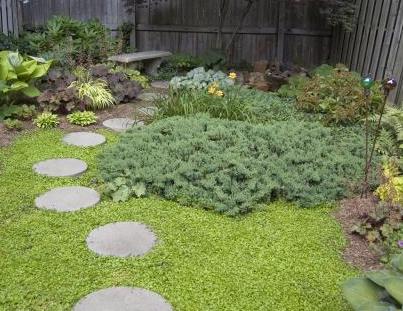 Long have I dreamt of an idyllic stone path with plantings leading from the back corner of my house into our treed, shady back yard. The opportunity to tame this neglected wild area became an immediate task after some recent construction.
Long have I dreamt of an idyllic stone path with plantings leading from the back corner of my house into our treed, shady back yard. The opportunity to tame this neglected wild area became an immediate task after some recent construction.
After ‘planting’ my stepping-stones, the question was what plants? Selecting plants requires answering several typical questions about light, water, soil and pH, and desired look. In addition to these more typical plant selection factors, function and use of the space further separates plant candidates. In my case, I needed the plants to tolerate some amount of moderate foot traffic (including my garden wheelbarrow).
While this side yard faces west, there are many trees preventing direct sunlight. High filtered light permeates the area most of the late morning until evening. Since the step stone area is at the bottom of a slope, there is a good amount of water when it rains. The soil is our native Virginia clay with an acid pH. My vision is filling in-between the stones and along the edges of planted beds with low, possibly creeping (but not aggressively so) plants. While flowering plants appeal to me, I recall the purple-blue flowers of Ajuga reptans in my childhood backyard and recoil at the number of bee or wasp stings my siblings and I endured. After many years of frequent stings and corresponding crying, our father pulled up all Ajuga and planted a grass that never really became lush.
Plant Choices
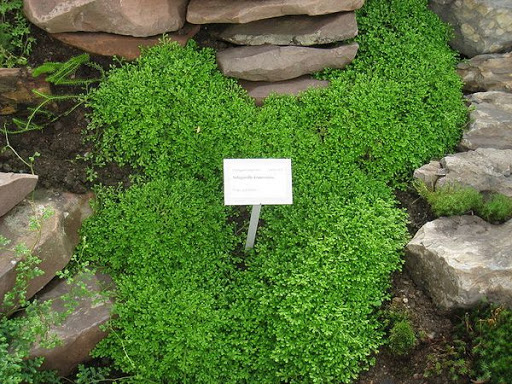
Selaginella kraussiana
Mazus reptans (Zones 5 to 8) — As a low (about 2 inches (5 cm) tall), creeping perennial, it forms a dense, green, almost evergreen carpet in our milder winters and roots wherever its stem nodes touch ground. Mazus tolerates light foot traffic and grows in full sun or part shade in moist or rich soil. In the late spring to early summer, it has purple flowers, and there is also a variety that has white flowers. With few insect or disease problems, it might be a good candidate.
Ornamental thymes (Zones 5 to 9) — Native to the Mediterranean, most members of the Thymus genus love full sun or light shade and dry soil. They tolerate some foot traffic and grow low to the ground usually under 2 to 4 inches (5-10 cm) tall. However, thyme does not thrive in partial to full shade, wet soil or in high humidity. Thymes are wonderful for their fragrance, flowers and prostrate characteristics.
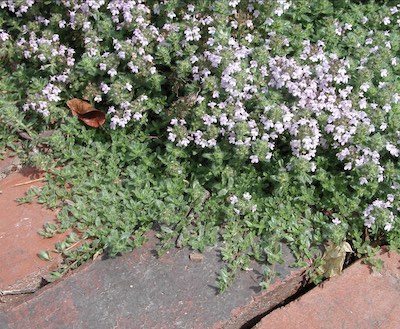
Thymus serpyllum
Brass buttons (Zones 4 to 10) — Leptinella squalida, a member of the Asteraceae family, is native to Australasia especially New Zealand and appears as a delicate fern-like, 2 inches (5 cm) tall, perennial ground cover that grows best in full sun and will tolerate partial shade in hot climates. While Zone 9 gardens can enjoy an evergreen, in our Zone 7a gardens it is likely that brass buttons will die back and look like a brown mass in the winter and early spring. In June and July, it blooms small yellow fuzzy flower ‘buttons.’ L. squalida spreads with runners, needs regular watering and shuns compacted soil. Because of its small scale, sometimes it is used in model railroads and miniature gardens.
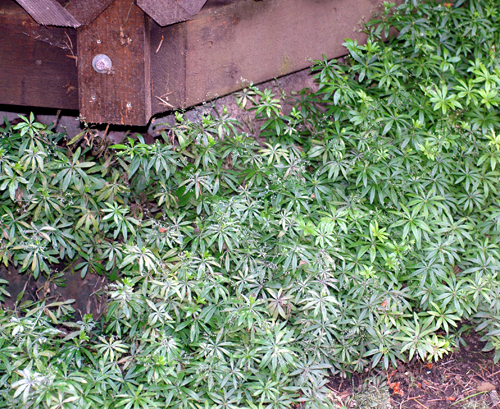
Galium odoratum
Blue star creeper (Zones 5 to 9) — Known by several scientific names, Pratia pedunculata, Lobelia pedunculata, and Isotoma fluviatilis, it is grown in full sun or partial shade in evenly moist soil. It is known as a plant with quick and aggressive spread by rhizomes to make a short 3-inch (7.6 cm) green carpet with pale blue flowers in spring and early summer. The flowers attract stinging pollinators. Because its growth knows no bounds, this creeper has a mass of web-like roots that are reportedly hard to pull if one decides that this plant is a space bully. Like some other creepers, it allows weeds and other plants to grow within its carpet.
Dwarf cinquefoil (Zones 4 to 8) — Potentilla neumanniana, a plant in the Rosaceae family, grows 2 to 4 inches (5-10 cm) tall in full sun to light shade in moist, well drained soils that are sandy to loamy. It has small, gold flowers in the spring [April to June]. Cinquefoil does not like to be moved once planted. It fades in full shade and performs poorly in hot, humid summers, like in our Zone 7a gardens.
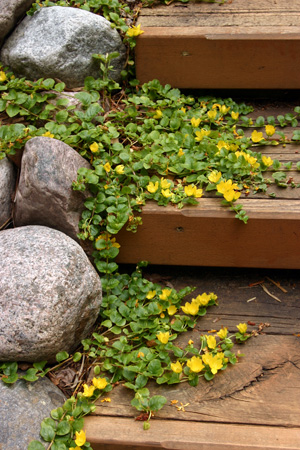
Lysimachia nummularia
In my shady, damp garden path, I am trying both Mazus reptans and Selaginella kraussiana. While both are newly planted, I can see that M. reptans’ joy for my shady, moist path is quickly expanding some thin growth beyond the limits of the space. Keeping it in line will add another gardening task. It is too early to pronounce any conclusion for Selaginella kraussiana, but I love its dense, soft green foliage.
Resources
• Brass Buttons, Leptinella squalida, Susan Mahr, University of Wisconsin — Madison, Master Gardener
Program
• Sweet Woodruff, Home Gardening Growing Guide, Cornell University
• Mazus reptans, Missouri Botanical Garden
• Leptinella squalida, Missouri Botanical Garden
• Potentilla neumanniana, Missouri Botanical Garden
• Lysimachia nummularia, Missouri Botanical Garden
• Plant of the Week: Thyme, Creeping, Mother of Thyme, Gerald Klingaman, University of Arkansas
Cooperative Extension Service